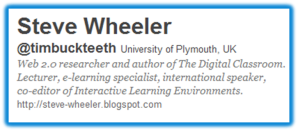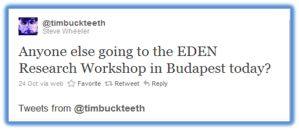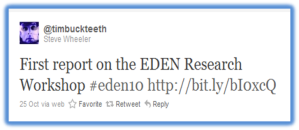This week is the final week of the POT Cert course and in order to be awarded the Program for Online Teaching Certificate, yah, I need to create a post that links to all my posts for the year, and make a brief statement about what each shows about my learning. So, here it is, a look back at my learning.

Week 23: I decided to make a short screencast presentation on the topic of personal learning networks (PLNs). In developing this presentation, I learned that although I thought I knew something about personal learning networks, it’s very difficult to actually demonstrate how one works. I also learned that it takes way more time and skill to execute a screencast presentation than I’d previously imagined.
Week 22: No surprise, I really enjoyed the topic this week, personal learning networks. The suggested readings really pulled together a lot of things for me. I was particularly glad to have learned more about Alec Couros and his approach to networked practice. I enjoyed writing my blog post too because I was able to connect it to activities in my own personal learning network.
Week 21: This week’s topic of learning theory was really tricky to post about. Not that I don’t understand learning theories by and large, just that it’s such an enormous topic. I was unable to watch Jenny Mackness’s video because I didn’t realise that my browser had fallen out with YouTube, so I decided to write a reply to Larry Sanger’s article, “Individual Knowledge in the Internet Age” instead. In truth, I just wanted to get the post out of the way; it wasn’t a great post, but I was glad that I posted something and that Jenny was interested enough to make comment because a very interesting discussion ensued.
Week 20: I called this post “the “golden triangle” of pedagogy, ed tech and instructional design”. Although the topic of the week was instructional design, I was interested to think about how all three of these disciplines fit together in the learning process. I had noted that I prefer to use the term learning design instead of instructional design, and Jim Julius enlightened me in the comments as to why there’s a variance in the terminology.
Week 19: Although web-enhanced, hybrid and open classes was the topic of the week, I took a slight detour from the text book to think about self-directed and self-determined learning, namely andragogy and heutagogy.
Week 18: The course, or learning management system is a topic that I seem to have been thinking about almost every week throughout the POT Cert course. What’s best, the institutional LMS, a self-hosted platform, or an assemblage of web tools cobbled together? Although I very much agree that “it’s time to think of the Internet, not the LMS, as our platform”, I still can’t fathom this question, and it appears that I’m not alone. See Lisa’s recent post on the subject.
Week 17: A bit of fun this week. Starring Lisa and Jim, I created an animation, which highlights Lisa M Lane’s tips for online course management.
Week 16: This week was all about preparing students for online learning”, so taking Ko and Rossen’s advice, and adhering to the course brief, I started to make an FAQ file of potential sticking points within my envisaged course. A very useful exercise that I must return to.
Week 15: Screencasting and multi media – I embedded a poll into my post and practised making a screencast.
Week 14: Audio and video – I tried out audioboo, soundgecko and eyejot. I was impressed with the possibilities that audio tools offer in the online classroom.
Week 13: Images and screenshots – I learned how to annotate images. However, I also learned that I’m a real novice when it comes to the using the photo sharing site Flickr and making the most of images in my work. This is definitely an area that I need to improve.
Week 12: Mid-term reflection.
Week 11: Class resources and intellectual property, this was a tough topic, but there were lots of good resources provided. The upshot being that I learned about Creative Commons and I now use a Creative Commons license on my blog posts and other work that I put out on the web. I also got to understand the reasoning behind remix culture. A good week’s work.
Week 10: With regards to the topic of open platforms for teaching and learning, I chose to investigate blogs, and how best to engage and develop students as bloggers. I also considered using blogs as ePortfolios.
Week 9: Student activities was this week’s topic, and the textbook chapter was very good in providing solid advice for organising, supervising and assessing group activities. I was particularly interested to learn how to facilitate effective group activities that prove to be satisfying for all concerned because in my experience of group work, there’s usually some element that doesn’t sit right for someone. I recalled an article about how to design effective online group work activities, which explained that the key to successful group work is to “design tasks that are truly collaborative, meaning the students will benefit more from doing the activity as a group than doing it alone”. The course textbook also provided a long list of student activities.
Week 8: Following on from week 7, this week’s topic was about creating community, and it considered the use of technology in such an endeavour. Technologies considered included not only the LMS, but a range of synchronous and audio technologies. I read “Envisioning the post-LMS Era: The Open Learning Network“, and considered the role that Twitter might play in all of this.
Week 7: I was “absent without leave” for this week’s topic of building community in the online classroom, so instead of posting anything of substance on the topic, I spent my time instead looking over the discussions that were already under way and offered comments where I felt I could add something of value or interest. I related my experience of using Twitter and consolidated my learning in my next blog post.
Week 6: This week was fun, as under the theme of internet skills and tools, I managed to demonstrate my fledgling knowledge of HTML code and understanding of the three different kinds of algorithms used for handling information: technological, personalised and social.
Week 5: Within the topic of the online syllabus, I found the recording of “The Interactive Syllabus” to be very useful. It highlighted the importance of taking account of the amount of clicking that a learner will have to do in order to arrive at the required location and gave practical instruction on how how to design this in. Rachele DeMeo’s presentation in Week 23 also demonstrated the importance of visual design in an online syllabus.
Week 4: Pedagogy and Course Design II – I entitled my post “designing authentic learning with ‘real’ people – a portfolio approach” as these are the key elements that I want to be present in the course that I have in mind.
Week 3: Pedagogy and Course Design I – I entitled my post “a ‘clean’ approach to course design” as I wanted to make the point that I was not converting an existing face-to-face course to an online format.
Week 2: In this introductory stage questions like “where the hell do I start?” were very real, and thanks to Lisa and the a whole bunch of people in the POT Cert community, I managed to make a start. I identified a textbook as my guiding force and was given lots of help and support in thinking about a platform for delivering an online course.
Week 1: Introduction and start blogging. Looking back, I’m struck by the imperative in the first week’s session to “start blogging”, and quite right too. I’d like to shout “start blogging” to everyone, because learning the discipline of blogging and forming a blogging habit has, for me, been one of the real gains from this course. I’ve not just learned about the course content, but I’ve developed my style as a blogger and in doing so, I’ve found my voice. By blogging, you not only reflect on and consolidate your learning but through the comments of others your learning continues to grow as you continue the conversation and make connections.
Looking back over all, I can say that I’ve achieved my goals for the POT Cert course. I’ve developed my knowledge and skills in relation to teaching online and I’ve put together the broad outline of a course that aims to deliver a practical introduction to digital literacies. To check my progress, I completed a self-assessment for online teaching, which proved to be a useful recap exercise. Notwithstanding the pedagogical aspects, it underlined that in order to deliver effective online programs rigorous planning, attention to detail and effective time management are at the heart of what’s required.
Finally, in all honesty, I joined up to the POT Cert course with no real idea what it would involve, but the experience has exceeded any expectations that I could have imagined, not only have I learned valuable stuff, but I’ve met lots of wonderful, open and generous people who’ve welcomed me into their community and helped me discover a new way of working. It’ll be a pleasure to pay my gratitude forward and help out with the next POT Cert course. I can definitely recommend it.
Thank you.
Image source: http://www.flickr.com/photos/mischiru/767491038/

This work is licensed under a Creative Commons Attribution-NonCommercial-ShareAlike 3.0 Unported License.



